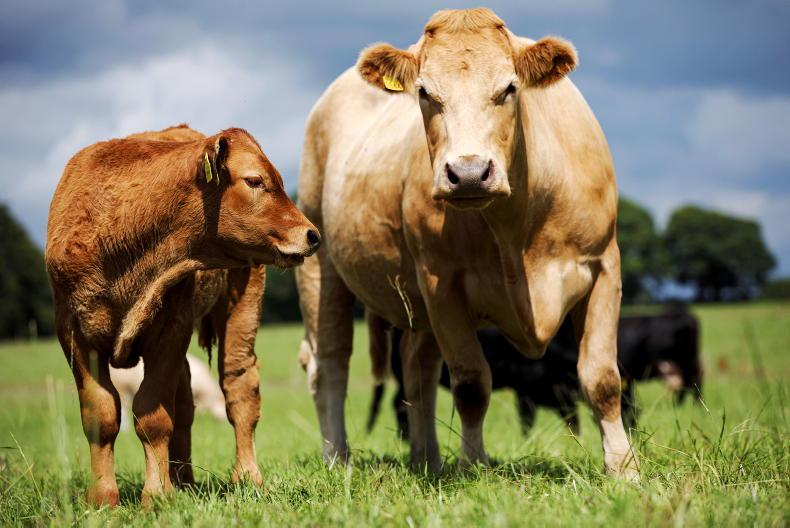Housing can be a risky time for suckler weanlings. There are many things to consider, including dietary changes, weaning, new groupings and the increased risk of respiratory disease.
Spring-born suckler calves generally remain with their dams at pasture until they are weaned, usually between five and nine months of age.
Weaning breaks the maternal offspring bond in suckler calves and removes milk from the calf’s diet as they become functioning ruminants.
In a natural environment, the cow would initiate weaning gradually by refusing the calf access to suckle at an older age than that which is generally practised by suckler farmers.
Weaning stress has an adverse effect on the immune system, making calves more susceptible to disease, particularly pneumonia. Weanling pneumonia, whether in dairy or beef calves, is a classic multi-factorial disease, and it is often caused by a combination of infectious agents and enhanced by inappropriate management.
The risk of pneumonia is increased by a range of events, including poor weaning management, completing painful procedures such as dehorning and castration at weaning and housing animals in sheds with poor ventilation (as contaminated air, dust, humidity and noxious gases are detrimental to calf health).
Wean outdoors
Plan to wean calves outdoors, where possible, and delay housing for at least three weeks (weather permitting). If weaning is done indoors, ensure housing facilities are fit for purpose.
Many farm buildings are poorly ventilated preventing stale air from escaping and resulting in damp, humid conditions in which a range of respiratory diseases thrive.
Stocking density, the slope of the roof (or height difference between air entering and leaving the building), and shed location are some factors that affect air quality. Ideally, weaned calves should not initially share airspace with adult animals.
Further details on shed design to ensure good ventilation can be found on the AHI website.
Nutrition
Good nutritional management pre-weaning is important to ensure a successful weaning. Prepare the calves gradually for the change in diet and make sure they are in good condition at weaning. This can be achieved by introducing concentrates to the calves at least one month prior to weaning and gradually increasing the allowance, having calves consuming at least 1kg/day at weaning time and continue feeding concentrates after weaning.
Access to clean, fresh water is essential to prevent dehydration which will increase the risk of pneumonia. There should be sufficient space for all animals to feed comfortably at the same time to reduce stress.
Wean calves by removing the cows (up one-third at a time) and not all the calves from the group. Removed cows should be moved out of sight and sound from the remaining group.
Wait before selling
Wait at least two weeks after weaning before selling the calves.
If you need to buy weanlings, plan a programme for purchasing weanlings where stress is minimised and where purchased animals are kept separate after arrival for at least four weeks, ideally outdoors or in open buildings before being housed with homebred animals. Ideally, purchasers should liaise with sellers to discuss weaning management practices prior to purchase.
Infectious agents
The most common infectious agents that cause weanling pneumonia are viruses including bovine herpesvirus 1, (BoHV1 -the virus that causes infectious bovine rhinotracheitis (IBR), bovine respiratory syncytial virus, (BRSV) and parainfluenza 3 virus (PI3V) and a number of bacteria.
Early diagnosis is essential for treatment success, and frequent observation is recommended post weaning.
If you suspect weanling pneumonia, consult your veterinary practitioner for advice on diagnosis and treatment
Initial signs of pneumonia can be non-specific and include being off form, dullness and reduced feed intake and lack of gut fill.
Other signs may include fever (over 39.5°C), increased respiratory rate, watery discharge and noticeable difficulty in breathing. By the time these later signs are noted, the disease is advanced and treatment is less likely to be successful as damage to the lungs may be irreversible.
If you suspect weanling pneumonia, consult your veterinary practitioner for advice on diagnosis and treatment.
There are many combinations of pneumonia vaccines available against the most commonly involved viral and bacterial agents.
Every farm should have a vaccination programme which has been designed specifically for the farm in conjunction with their veterinary practitioner.
No vaccine completely eliminates the risk of disease, but they are certainly a great help in reducing disease severity when administered correctly to healthy animals that are able to respond appropriately to the vaccine.
Vaccines need time to build up protection, and should be given well in advance of weaning and housing to have the best effect.
In certain situations, intranasal vaccines may be used in the face of a viral respiratory disease outbreak. It is vital whatever the vaccine programme, that vaccines are stored and administered as per manufacturer’s instructions.
Determining the parasite or worm status of your weanlings prior to weaning is essential to ensure they are as healthy as possible at housing.
All parasites have a negative effect on the weanling’s immune system and lungworm, in particular, can damage the lungs and increase the risk and severity of pneumonia.
Not only do adult lungworm cause irritation and obstruct the airways, the larvae (young lungworm) damage the lung tissue preventing the lungs from functioning properly, making them more susceptible to infection by both viruses and bacteria.
Lungworm are killed and removed quickly after dosing, but it can take two to three weeks for the lung tissue to heal.






 This is a subscriber-only article
This is a subscriber-only article










SHARING OPTIONS: